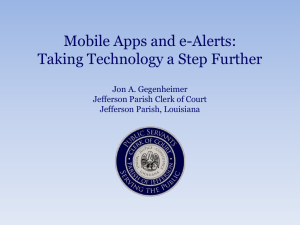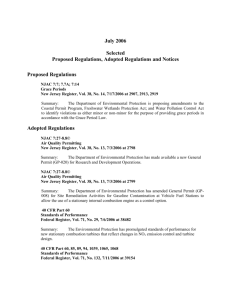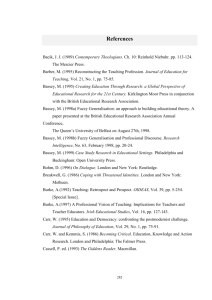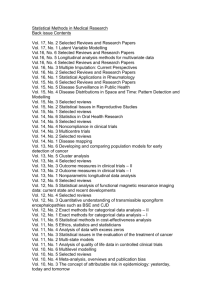the leadership qualities of town/parish clerks
advertisement
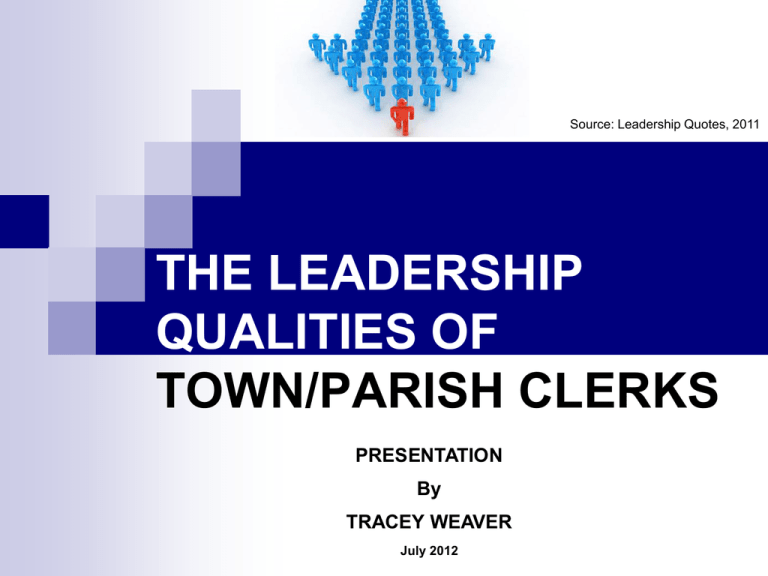
Source: Leadership Quotes, 2011 THE LEADERSHIP QUALITIES OF TOWN/PARISH CLERKS PRESENTATION By TRACEY WEAVER July 2012 Agenda Reason for study Dissertation aims & objectives Literature review Hypotheses and Research Methodology Results Conclusion/Recommendations Questions Reasons for Study Personal development Understanding the leadership function in the clerks role Guidance and standardisation What is Leadership? Northouse (2003: 3) defines leadership as “a process whereby an individual influences a group of individuals to achieve a common goal” Dissertation Aims & Objectives Aim – To establish that leadership is a recognised function in the role of a town/parish clerk. Objectives – Research leadership theories Leadership qualities in the role of a clerk Leadership resources To provide guidance Literature Review Leadership Role of the town/parish clerk Leadership theories and styles “leaders and followers make each other advance to a higher level of moral and motivation." (Burns: 1978). Servant-leadership vs Leadership “It begins with the natural feeling that one wants to serve, to serve first. Then conscious choice brings one to aspire to lead. That person is sharply different from one who is leader first, perhaps because of the need to assuage an unusual power drive or to acquire material possessions…The leader-first and the servant-first are two extreme types. Between them there are shadings and blends that are part of the infinite variety of human nature.” (Greenleaf, 1970). Hypotheses “Town/parish clerks have a servant-leadership role within town/parish councils” Research Questions The importance of leadership in the role of the clerk Is leadership in the role of the clerk recognised by councils Leadership qualities of the clerk Is there a lack of resources Research Methodology Secondary research Primary research - Quantitative questionnaire - Qualitative interviews - Comparison study of clerks job descriptions Initial Research Results Map showing the Geographical Representation of Responses from each District in Devon. 11.25% 10.00% A total of 81 response were received out 357. 20.00% 25.00% 6.25% 0% 8.75% 18.75% Devon County Council, 2011 Do you think leadership is important in the role of a town/parish clerk? yes no 4% did not answer 23% 73% Is leadership mentioned in your job description? yes 10% no 5% did not answer 85% Importance of Leadership “The Clerk has great influence of knowledge and time spent and if used with tact Members will be influenced.” (Respondent No. 4). “Sometimes it is necessary to lead and guide the Parish Council to achieve the goals they have set.” (Respondent No. 9). “The council leads; I try to influence them to do the right thing efficiently, but not by leading.” (Respondent No. 67). “As the 'expert' resource to the Council and the responsible officer there are many instances where you need to steer/guide/lead on policy/projects/planning etc and have the long term vision too.” (Respondent No. 23). Ho C n Kn o n est ow fid y le enc dg e In e a te ble llig en ce Ab i Li lity st en e Do r in St g r Fa ong irn es s Vi s Re ion W s Co ill pe c in t Pe mp g n Ta op ass ess Co ke le ion m pl cr or i a t y iti en e wi cis ta th m ted ru /a le En d vi s an th ce d u pr sia oc sm ed ur M e ot P iva as s t in s io g n ot In he no r s va t iv e Which of the following qualities do you think makes a good leader? 70% 60% 50% 40% 30% 20% 10% 0% Do you think there are enough resources on leadership to help town/parish clerks? 35 30 25 20 15 Not relevant 10 No 5 Yes Training Published Literature Government Guidance 0 Conclusion/Recommendations Standardised job description. leadership programmes to include the first tier of local government. Specific training on leadership within the sector The SLCC, ILCM, UOG and NALC to continue further studies including: - is leadership viable and relevant to all P&T clerks. - do elected members recognise leadership within the P&T clerk’s role. - should there be more training on leadership available to local councils. Discussion/Questions Source: Cheshire Home Choice, 2011 Bibliography – Key literature Alban-Metcalfe, J. & Alimo-Metcalfe, B. (2010) Integrative leadership, partnership working and wicked problems: a conceptual analysis, International Journal of Leadership in Public Services. Vol 6, Issue 3, 3-13. Banyai, C. (2009) Community Leadership: Development and the evolution of leadership in Himeshima, Rural Society. Vol. 19, Issue 3, 241-261. Cheshire Home Choice (2011) [online image] Available from: http://www.cheshirehomechoice.org.uk/Data/ASPPages/1/35.aspx [Accessed 13/01/12] Cox, B. (2010) Leading and following together – leading leadership and leading leaders, International Journal of Leadership in Public Services. Vol. 6, Issue 1, 14-17. Drucker, P. F. (1997) The leader of the future: New visions, strategies, and practices for the next era. Jossey-Bass: San Francisco. Duan, J., Lam, W., Chen, Z. & Zhong, J. (2010) Leadership justice, negative organizational behaviours, and the mediating effect of affective commitment, Social behaviour and personality. Vol. 38, Issue 9, 1287-1296. Dynamic Transition Ltd. (2010) Developing Leadership [online] Available from: http://www.developing-leadership.com/definitionof-leadership.html [Accessed 12/11/11]. Edersheim EH. (2007) The Definitive Drucker. New York: McGraw-Hill. Gill, R. (2009) Leadership in public services and the private sector: a comparison and the implications for handling crises and emergencies, International Journal of Leadership in Public Services. Vol. 5, Issue 4, 20-26. Gonzaga University. & Greenleaf, R. K. (2005) The International Journal of Servant Leadership. Vol. 3 No. 1 Greenleaf, R. K. (1970) A life of servant leadership, Berrett-Koehler Publishing Inc: San Francisco. Grint, K. (2010) Leadership: an enemy of the people? International Journal of Leadership in Public Services. Vol. 6, Issue 4, 2225. Gunter, H. (2009) The leadership delusion, International Journal of Leadership in Public Services. Vol. 5, Issue 3, 50-54. Katene, S. (2010) Modelling leadership: What makes for good leadership? MAI Review, 1-16. Kendrick, M. & Sullivan, L. (2009) Appraising the leadership challenges of social inclusion, International Journal of Leadership in Public Services. Vol. 5, 67-76. Kleon, S. & Rinehart, S. (1998) Leadership skill development of teen leaders, Extension Journal. Vol. 36 No. 3 Korek, S., Felfe, J. & Zaepernick-Rothe, U. (2009) Transformational leadership and commitment: A multilevel analysis of group-level influences and mediating processes, European Journal of Work and Organizational Psychology. Vol. 19, Issue 3, 364-387. Lawson, I. & Cox, B. (2010) Exceeding Expectation: The principles of outstanding leadership, International Journal of Leadership in Public Services. Vol. 6, Issue 1, 4-13. Leadership Quotes (2011) [online image] Available from: http://www.leadership-quotes.org/articles/leadership-basics [Accessed 03/01/12] Northouse, P. G. (2007) Introduction to Leadership: Concepts and Practices, Sage Publications Inc: London. Patterson, K. A. (2003) Servant Leadership: A theoretical model. Doctoral dissertation, Regent University.` Powe, J. (2010) When the going gets tough…Public service leadership in times of significant change and uncertainty, International Journal of Leadership in Public Services. Vol. 6, Issue 4, 9-17. Ryde, R. (2009) New insights and new possibilities for public service leadership, International Journal of Leadership in Public Services. Vol. 5, Issue 4, 5-19. Selwyn, K. (2010) Modelling Maori Leadership: What makes for good leadership? MAI Review, 1-16. Sergiovanni, T. (1982) Ten Principles of Quality Leadership, Educational Leadership. 330-336. Stodgill, R. M. (1974) Handbook of Leadership: A survey of theory and research, Free Press: New York. Yukl, G. (1999) An evaluative essay on current conceptions of effective leadership, European Journal of Work and Organizational Psychology. Vol. 8, No. 1 33-48. The End……








